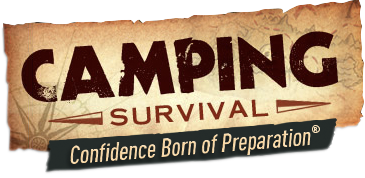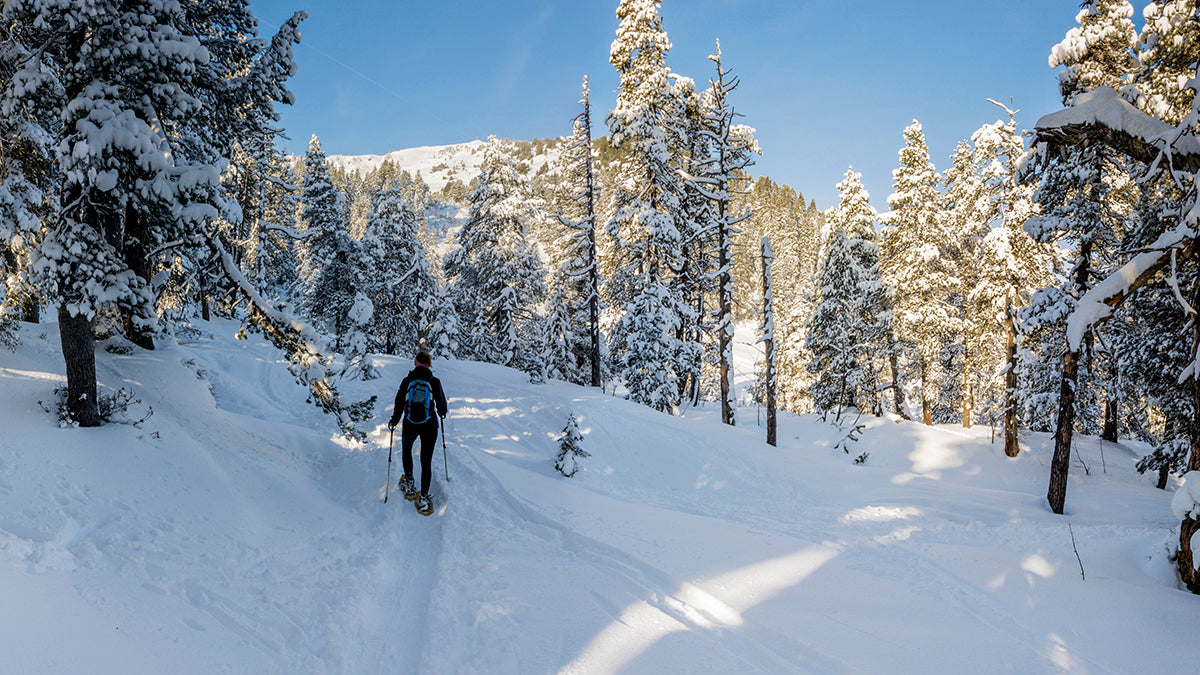The deeper we get into winter, the more the wilderness is muted and buried under a piling sea of white. This is no ordinary terrain; it’s a deadly ecosystem where every step counts.
As fellow survivalists of the backcountry’s harshest season, we’re going to share the lifesaving art of moving through deep snow—vital knowledge if you want to be prepared for anything.
Understanding Snowy Terrain
Snow, in its various forms, presents distinct challenges to the backcountry survivalist. Recognizing and understanding these snow types is critical for selecting the appropriate gear and adopting the correct techniques for safe, efficient navigation.
Powdery Snow
This type of snow is characterized by its light, fluffy texture. It's often found after a fresh snowfall when temperatures are still cold. While powdery snow offers less resistance to movement, it can obscure hazards underneath, such as rocks or crevasses.
Identifying powdery snow is easy due to its loose and unconsolidated nature, and it often creates a cloud of snow dust when disturbed.
Crust Snow
Formed when the surface of snow melts and refreezes, crust snow has a hard, icy top layer with softer snow beneath. It can be challenging to navigate as the top layer sometimes supports weight and other times breaks under pressure, leading to an uneven and tiring trek.
Recognizing crust snow involves looking for a shiny or glazed surface, which indicates a refrozen top layer.
Wet Snow
This snow type is common during warmer weather or when the sun heats the snow’s surface. It's heavier and denser than powdery snow, making it more exhausting to move through.
Wet snow tends to clump together and may stick to snowshoes or skis. It can be identified by its slushy texture and the ability to compact easily into snowballs.
Wind-Packed Snow
Often found in open areas with strong winds, this type of snow is dense and compacted. It can provide a firmer surface for travel, but can also hide harder ice layers or snowdrifts.
Wind-packed snow is characterized by its smooth, often rippled surface, which indicates wind has moved and compressed the snow.
Corn Snow
Common in the spring, corn snow is created by repeated melting and refreezing cycles. It has a unique granular texture—resembling kernels of corn—and can be enjoyable to navigate on due to its soft, forgiving nature during the day.
It's identified by a granular, almost coarse texture, and typically found during periods of thaw.
Depth Hoar
This forms near the ground as the snowpack matures and is characterized by large, loose crystals that can weaken the snowpack. It's a key contributor to avalanche conditions.
Depth hoar can be identified by its sugary, loose crystals at the base of the snowpack, usually revealed in a snow pit.
Slab Snow
This is a cohesive layer of snow that can be prone to avalanches. It often forms over a weaker layer of snow, like depth hoar, and can be triggered by additional weight.
Identifying slab snow involves looking for a hard, cohesive layer of snow over a softer, weaker layer.

Techniques for Efficient Snow Travel
Snowshoeing Basics
Proper Technique – Snowshoeing hinges on technique. A steady, rhythmic pace conserves energy. You must lift the foot with the knee, rather than the hip, to move through deep snow efficiently. Poles are not just for balance; they help propel you forward, reducing the workload on your legs. For more on winter survival techniques, check out this guide.
Weight Distribution – Snowshoes work by distributing your weight over a larger area. Properly adjusted bindings are crucial. They should be snug to avoid energy-wasting slippage, but not so tight that they cut off circulation.
Terrain Navigation – On uphill treks, use the toe crampons and lean forward. When descending, lean back slightly to dig the heel crampons into the snow. On sidehill traverses, keep your weight on the uphill edge of the snowshoes to maintain traction.
RELATED READ: Surviving the Unthinkable: How to Stay Alive in the World's Most Extreme Environments
Cross-Country Skiing Tips
Glide and Balance – Efficient cross-country skiing is about balance and a smooth glide. The diagonal stride involves pushing off one ski while gliding on the other, akin to a rhythmic walk or run. Using poles for both balance and propulsion is key.
Weight Transfer – Transferring your weight from ski to ski is fundamental. This transfer should be complete and deliberate with each stride, enabling a longer glide and conserving energy.
Pole Use – Poles are not merely for balance; they're an integral part of propulsion. Timing your pole plant with the opposite ski's forward movement maximizes efficiency.
Downhill Techniques – When skiing downhill, techniques like the snowplow or telemark turn help control speed and maintain balance.
Trail Breaking
Efficient Path Creation – Breaking a trail in fresh snow is demanding. The leader should aim to create a smooth, consistent path. This involves stepping in a rhythmic, deliberate manner, conserving energy with each step.
Switching Leaders – Regularly rotating the leader in the group helps distribute the energy expenditure. The person in front breaks the trail, while those following step in the established path.
Path Width and Depth – The path should be just wide enough for the group to follow. Deeper snow requires a shallower trail to maintain energy levels.

Navigating Common Snow Hazards
Avoiding Avalanches
Recognizing Danger Signs – Be aware of telltale signs of avalanches, such as recent heavy snowfall, wind-deposited snow, and a hollow or ‘whoomph’ sound indicating a weak snow layer. Observing the terrain for signs of previous slides is also crucial. To learn more about avalanche safety, you can refer to this guide.
Terrain Analysis – Slopes between 30 and 45 degrees are most prone to avalanches. Avoiding these areas, especially during high-risk conditions, is vital.
Safety Equipment – Always carry avalanche safety equipment like a beacon, probe, and shovel. Knowing how to use this equipment is as crucial as carrying it.
Crossing Ice Safely
Assessing Ice Strength – Ice strength can be deceptive. Clear, blue ice is typically stronger than white or opaque ice. Using an ice auger or spud bar to check ice thickness is recommended.
Spreading Weight – If you must cross ice, lying down to spread your weight or using a long pole can reduce the risk of falling through.
Escape Strategies – Knowing how to react if you fall through the ice is especially important. Remember to stay calm, try to remain horizontal, and kick to propel yourself back onto solid ice.
RELATED READ: The 10 Cs of Preparedness—Plus 5 More You Haven’t Heard Before
Dealing with Whiteouts
Orientation – Visibility is near zero in whiteouts, making navigation extremely challenging. Using a compass and GPS to maintain your bearing is essential.
Landmarks and Route Memory – If possible, use identifiable landmarks or memorize your route to aid navigation. Setting waypoints on a GPS device before visibility decreases can be lifesaving.
Avoid Disorientation – Move slowly and deliberately. Constantly check your compass or GPS to ensure you're on course. You can never be too safe!

Snow Navigation Strategies
Route Planning
Considering Terrain and Weather – Plot your route considering both the terrain's complexity and weather forecast. Avoid avalanche-prone slopes and areas with other known hazards.
Daylight Management – Be aware of the limited daylight hours in winter. Plan to complete your travel during daylight to avoid the increased risks that come with darkness. For more detailed tips on winter survival, the National Weather Service offers comprehensive winter weather information here.
Energy Conservation
Pacing – Maintaining a steady pace that you can sustain over a long distance is crucial. Avoiding excessive sweating is key, as it can lead to freezing when you stop moving.
Regular Breaks – Take regular breaks to rest and hydrate. This helps maintain your energy levels and prevent fatigue.
Group Travel
Communication – Clear and continuous communication among group members ensures everyone is aware of any changes in conditions or route.
Formation and Pace – Keeping the group in a formation where everyone can see each other, plus maintaining a pace that suits the slowest member, ensures safety for all. This approach prevents anyone from being left behind and allows for immediate assistance if someone encounters difficulties.
Emergency Preparedness – Always have a plan for emergencies. This includes having a designated leader, knowing each member's capabilities and limitations, and carrying emergency communication devices such as satellite phones or personal locator beacons.
Navigating through deep snow is a skill that requires understanding, preparation, and practice. With the right knowledge and techniques, wilderness survivalists can travel across snowy terrains without hesitation.
This guide aims to equip survivalists with the skills needed to navigate the challenges of winter wilderness, ensuring their adventures are as safe as they are exhilarating.


0 comments